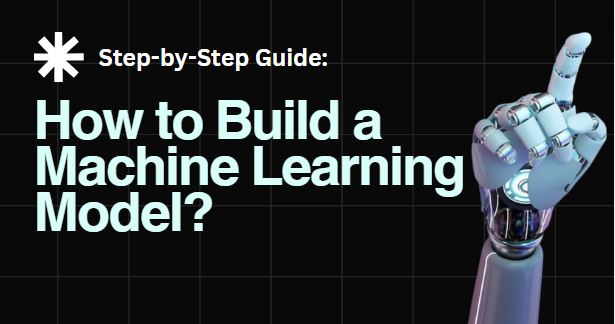
Building a machine learning model may seem daunting, but with a clear, step-by-step approach, you can simplify the process and create models that can drive meaningful insights. Whether you’re a beginner or looking to refine your skills, this guide will walk you through the essential steps of building a machine learning model, from data preprocessing to model evaluation.
Step 1: Define the Problem
The first and most crucial step in building a machine learning model is to clearly define the problem you’re trying to solve. Ask yourself:
- What is the objective of the model?
- What are the expected outputs?
- What kind of data is available, and what kind of data do you need?
A well-defined problem will guide your entire modeling process, helping you choose the right algorithms and metrics.
Step 2: Collect and Prepare Data
Data is the foundation of any machine learning model. Here’s how to handle it:
- Data Collection: Gather relevant data from available sources. The data can come from databases, APIs, web scraping, or even manual input.
- Data Cleaning: Remove duplicates, handle missing values, and correct errors. Clean data ensures that the model learns correctly and performs well.
- Data Transformation: Transform the data into a suitable format. This could involve converting text to numbers, normalizing values, or encoding categorical data.
- Data Splitting: Split your data into training and testing sets. A typical split is 80% for training and 20% for testing. This allows you to train your model on one set of data and test its performance on another.
Step 3: Choose a Model
Selecting the right machine learning model is essential. The choice depends on the type of problem (classification, regression, clustering) and the data at hand. Some popular models include:
- Linear Regression for predicting numerical values.
- Decision Trees for classification problems.
- Support Vector Machines (SVM) for binary classification.
- Neural Networks for complex, non-linear problems.
Step 4: Train the Model
Training the model involves feeding the training data into the chosen algorithm. The model learns by adjusting its parameters to minimize errors. Here’s what happens during training:
- Algorithm Application: The algorithm processes the input data and generates predictions.
- Error Calculation: The model’s predictions are compared to the actual values, and an error metric (like Mean Squared Error for regression) is calculated.
- Parameter Adjustment: The model adjusts its parameters to reduce the error.
This process is repeated multiple times (iterations) until the model achieves an acceptable level of accuracy.
Step 5: Evaluate the Model
Once the model is trained, it’s time to evaluate its performance on the testing data. Key metrics for evaluation include:
- Accuracy: The percentage of correct predictions.
- Precision and Recall: Measures of the model’s ability to correctly identify true positives and avoid false negatives.
- F1 Score: The harmonic mean of precision and recall, especially useful for imbalanced datasets.
- ROC-AUC Curve: A graphical representation of the model’s performance across different thresholds.
Evaluation helps you understand how well the model generalizes to unseen data and identifies areas for improvement.
Step 6: Tune Hyperparameters
Hyperparameters are settings that control the training process of the model, such as the learning rate, number of trees in a random forest, or the depth of a decision tree. Tuning these parameters can significantly improve model performance. Techniques like Grid Search, Random Search, and Bayesian Optimization are commonly used for hyperparameter tuning.
Step 7: Deploy the Model
Once the model is trained, tested, and tuned, it’s ready for deployment. Deployment involves integrating the model into a production environment where it can be used to make predictions on new data. Monitoring the model in production is crucial to ensure it continues to perform well as new data becomes available.
Step 8: Monitor and Maintain the Model
Post-deployment, continuous monitoring is essential to ensure that the model remains accurate and relevant. If the model’s performance degrades over time, it might be necessary to retrain it with new data or adjust its parameters.
How MITSDE Provides the Best AI and Machine Learning Education to Students
Building a machine learning model requires a deep understanding of both the theoretical concepts and practical applications of AI and machine learning. At the MIT School of Distance Education (MITSDE), we offer an exceptional learning experience that equips students with the skills and knowledge needed to excel in this dynamic field.
Comprehensive Curriculum
MITSDE’s AI and Machine Learning programs cover all the critical aspects of machine learning, from the fundamentals to advanced topics. The curriculum is designed with input from industry experts, ensuring that students gain knowledge that is both current and relevant. Topics include:
- Data Science Essentials
- Machine Learning Algorithms
- Neural Networks and Deep Learning
- Data Preprocessing Techniques
- Model Evaluation and Tuning
Hands-on Learning
At MITSDE, we believe that practical experience is crucial. Our programs include hands-on projects and real-world case studies that allow students to apply what they’ve learned. Whether it’s building a simple linear regression model or deploying a complex neural network, students gain valuable experience that prepares them for the demands of the industry.
Expert Faculty
Our faculty consists of experienced professionals and academics who are leaders in the field of AI and machine learning. They bring their industry insights into the classroom, offering students a blend of theoretical knowledge and practical wisdom. This ensures that MITSDE students are well-prepared to tackle real-world challenges.
Flexibility for Working Professionals
Understanding the needs of working professionals, MITSDE offers flexible online learning options. Students can access course materials, participate in discussions, and complete assignments at their own pace, allowing them to balance their education with their professional responsibilities.
Career Support and Networking Opportunities
MITSDE provides robust career support, including resume writing workshops, interview preparation, and placement assistance. Additionally, students have the opportunity to network with peers, faculty, and industry professionals, building connections that can significantly impact their careers.
Conclusion: Build Your Future with MITSDE
Building a machine learning model is an intricate process that requires a solid foundation in AI and machine learning. MITSDE’s comprehensive programs offer students the knowledge, skills, and experience needed to succeed in this rapidly evolving field. Whether you’re looking to start a career in machine learning or enhance your current skill set, MITSDE provides the education and support you need to achieve your goals.
Take the first step towards a successful career in AI and machine learning with MITSDE. Your journey to becoming a skilled machine learning professional starts here!

